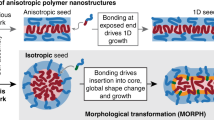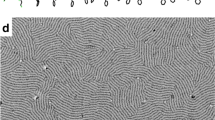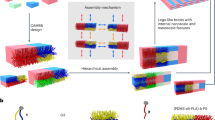Abstract
Organized arrays of anisotropic nanoparticles show electronic and optical properties that originate from the coupling of shape-dependent properties of the individual nanorods. The organization of nanorods in a controllable and predictable way provides a route to the fabrication of new materials and functional devices. So far, significant progress has been achieved in the self-assembly of nanorod arrays, yet the realization of a range of different structures requires changing the surface chemistry of the nanoparticles. We organized metal nanorods in structures with varying geometries by using a striking analogy between amphiphilic ABA triblock copolymers and the hydrophilic nanorods tethered with hydrophobic polymer chains at both ends. The self-assembly was tuneable and reversible and it was achieved solely by changing the solvent quality for the constituent blocks. This approach provides a new route to the organization of anisotropic nanoparticles by using the strategies that are established for the self-assembly of block copolymers.
This is a preview of subscription content, access via your institution
Access options
Subscribe to this journal
Receive 12 print issues and online access
$259.00 per year
only $21.58 per issue
Buy this article
- Purchase on Springer Link
- Instant access to full article PDF
Prices may be subject to local taxes which are calculated during checkout





Similar content being viewed by others
References
Murphy, C. J. et al. Anisotropic metal nanoparticles: Synthesis, assembly, and optical applications. J. Phys. Chem. B 109, 13857–13870 (2005).
Murphy, C. J., Gole, A. M., Hunyadi, S. E. & Orendorff, C. J. One-dimensional colloidal gold and silver nanostructures. Inorg. Chem. 45, 7544–7554 (2006).
Xia, Y. N. et al. One-dimensional nanostructures: Synthesis, characterization, and applications. Adv. Mater. 15, 353–389 (2003).
Jain, P. K., Eustis, S. & El-Sayed, M. A. Plasmon coupling in nanorod assemblies: Optical absorption, discrete dipole approximation simulation, and exciton-coupling model. J. Phys. Chem. B 110, 18243–18253 (2006).
Hu, J. T. et al. Linearly polarized emission from colloidal semiconductor quantum rods. Science 292, 2060–2063 (2001).
Huynh, W. U., Dittmer, J. J. & Alivisatos, A. P. Hybrid nanorod-polymer solar cells. Science 295, 2425–2427 (2002).
Sudeep, P. K., Joseph, S. T. S. & Thomas, K. G. Selective detection of cysteine and glutathione using gold nanorods. J. Am. Chem. Soc. 127, 6516–6517 (2005).
Huang, X. H., El-Sayed, I. H., Qian, W. & El-Sayed, M. A. Cancer cell imaging and photothermal therapy in the near-infrared region by using gold nanorods. J. Am. Chem. Soc. 128, 2115–2120 (2006).
Gorelikov, I., Field, L. M. & Kumacheva, E. Hybrid microgels photoresponsive in the near-infrared spectral range. J. Am. Chem. Soc. 126, 15938–15939 (2004).
Salem, A. K., Searson, P. C. & Leong, K. W. Multifunctional nanorods for gene delivery. Nature Mater. 2, 668–671 (2003).
Thomas, K. G., Barazzouk, S., Ipe, B. I., Joseph, S. T. S. & Kamat, P. V. Uniaxial plasmon coupling through longitudinal self-assembly of gold nanorods. J. Phys. Chem. B 108, 13066–13068 (2004).
Joseph, S. T. S., Ipe, B. I., Pramod, P. & Thomas, K. G. Gold nanorods to nanochains: Mechanistic investigations on their longitudinal assembly using alpha, omega-alkanedithiols and interplasmon coupling. J. Phys. Chem. B 110, 150–157 (2006).
Caswell, K. K., Wilson, J. N., Bunz, U. H. F. & Murphy, C. J. Preferential end-to-end assembly of gold nanorods by biotin-streptavidin connectors. J. Am. Chem. Soc. 125, 13914–13915 (2003).
Dujardin, E., Hsin, L. B., Wang, C. R. C. & Mann, S. DNA-driven self-assembly of gold nanorods. Chem. Commun. 14, 1264–1265 (2001).
Zhang, Q. L., Gupta, S., Emrick, T. & Russell, T. P. Surface-functionalized CdSe nanorods for assembly in diblock copolymer templates. J. Am. Chem. Soc. 128, 3898–3899 (2006).
Correa-Duarte, M. A., Perez-Juste, J., Sanchez-Iglesias, A., Giersig, M. & Liz-Marzan, L. M. Aligning Au nanorods by using carbon nanotubes as templates. Angew. Chem. Int. Edn 44, 4375–4378 (2005).
Gupta, S., Zhang, Q. L., Emrick, T. & Russell, T. P. “Self-corralling” nanorods under an applied electric field. Nano Lett. 6, 2066–2069 (2006).
Ryan, K. M., Mastroianni, A., Stancil, K. A., Liu, H. T. & Alivisatos, A. P. Electric-field-assisted assembly of perpendicularly oriented nanorod superlattices. Nano Lett. 6, 1479–1482 (2006).
Park, S., Lim, J. H., Chung, S. W. & Mirkin, C. A. Self-assembly of mesoscopic metal-polymer amphiphiles. Science 303, 348–351 (2004).
Discher, D. E. & Eisenberg, A. Polymer vesicles. Science 297, 967–973 (2002).
Yan, X. H., Liu, G. J. & Li, Z. Preparation and phase segregation of block copolymer nanotube multiblocks. J. Am. Chem. Soc. 126, 10059–10066 (2004).
Knauss, D. M. & Huang, T. Z. Star-block-linear-block-star triblock (pom-pom) polystyrene by convergent living anionic polymerization. Macromolecules 35, 2055–2062 (2002).
Nikoobakht, B. & El-Sayed, M. A. Preparation and growth mechanism of gold nanorods (NRs) using seed-mediated growth method. Chem. Mater. 15, 1957–1962 (2003).
Zhulina, E. B., Birshtein, T. M. & Borisov, O. V. Curved polymer and polyelectrolyte brushes beyond the Daoud-Cotton model. Eur. Phys. J. E 20, 243–256 (2006).
Wolf, B. A. & Willms, M. M. Measured and calculated solubility of polymers in mixed-solvents-Co-non-solvency. Makromol. Chem. 179, 2265–2277 (1978).
Schulz, G. V. & Baumann, H. Thermodynamic properties expansion coefficient and viscosity value of polystyrene in tetrahydrofuran. Makromol. Chem. 114, 122–138 (1968).
Rubinstein, M. & Colby, R. H. Polymer Physics (Oxford Univ. Press, Oxford, 2003).
Israelachvili, J. N. Intermolecular and Surface Forces (Academic, London, 1992).
Lairez, D., Adam, M., Carton, J. P. & Raspaud, E. Aggregation of telechelic triblock copolymers: From animals to flowers. Macromolecules 30, 6798–6809 (1997).
Raspaud, E., Lairez, D., Adam, M. & Carton, J. P. Triblock copolymers in a selective solvent. 1. Aggregation process in dilute-solution. Macromolecules 27, 2956–2964 (1994).
Tenbrinke, G. & Hadziioannou, G. Topological constraints and their influence on the properties of synthetic macromolecular systems. 2. Micelle formation of triblock copolymers. Macromolecules 20, 486–489 (1987).
Wang, Y. M., Mattice, W. L. & Napper, D. H. Simulation of the self-assembly of symmetrical triblock copolymers in dilute-solution. Macromolecules 25, 4073–4077 (1992).
De Gennes, P. G., Brochard-Wyart, F. & Quere, D. Capillarity and Wetting Phenomena: Drops, Bubbles, Pearls, Waves (Springer, New York, 2004).
Su, K. H. et al. Interparticle coupling effects on plasmon resonances of nanogold particles. Nano Lett. 3, 1087–1090 (2003).
Link, S., Mohamed, M. B. & El-Sayed, M. A. Simulation of the optical absorption spectra of gold nanorods as a function of their aspect ratio and the effect of the medium dielectric constant. J. Phys. Chem. B 103, 3073–3077 (1999).
Shan, J. et al. Amphiphilic gold nanoparticles grafted with poly(N-isopropylacrylamide) and polystyrene. Macromolecules 38, 2918–2926 (2005).
Zubarev, E. R., Xu, J., Sayyad, A. & Gibson, J. D. Amphiphilicity-driven organization of nanoparticles into discrete assemblies. J. Am. Chem. Soc. 128, 15098–15099 (2006).
Zubarev, E. R., Xu, J., Sayyad, A. & Gibson, J. D. Amphiphilic gold nanoparticles with V-shaped arms. J. Am. Chem. Soc. 128, 4958–4959 (2006).
Acknowledgements
E.K. is grateful for Canada Research Chair financial support (NSERC Canada). G.C.W. gratefully acknowledges NSERC Canada (grant 312497), NSF (grant CHE-0404579), ONR (grant N00014-05-10765), ARO (grant W911NF-04-1-0191) and NIH (grant 1 R21 EB003101-01) for financially supporting this work. M.R. acknowledges financial support from NSF (grants CHE-0616925 and CTS-0609087), NIH (grant 1-R01-HL0775486A) and NASA (agreement NCC-1-02037). The authors thank Y. Wang for assistance in the synthesis of thiol-terminated polystyrene and D. Shirvanyants for assistance in image analysis.
Author information
Authors and Affiliations
Contributions
Z.N. was responsible for project planning, data analysis and experimental work, D.F. was responsible for experimental work, S.Z. was responsible for experimental work and data analysis, G.C.W. and M.R. were responsible for data analysis and interpretation and E.K. was responsible for project planning and data analysis and interpretation.
Corresponding author
Ethics declarations
Competing interests
The authors declare no competing financial interests.
Supplementary information
Supplementary Information
Supplementary information and figures S1-S5 (PDF 1724 kb)
Rights and permissions
About this article
Cite this article
Nie, Z., Fava, D., Kumacheva, E. et al. Self-assembly of metal–polymer analogues of amphiphilic triblock copolymers. Nature Mater 6, 609–614 (2007). https://doi.org/10.1038/nmat1954
Received:
Accepted:
Published:
Issue Date:
DOI: https://doi.org/10.1038/nmat1954
This article is cited by
-
Symmetry-breaking in patch formation on triangular gold nanoparticles by asymmetric polymer grafting
Nature Communications (2022)
-
Crystallization of nanoparticles induced by precipitation of trace polymeric additives
Nature Communications (2021)
-
Self-regulated co-assembly of soft and hard nanoparticles
Nature Communications (2021)
-
Metal–polymer-coordinated complexes as potential nanovehicles for drug delivery
Journal of Nanostructure in Chemistry (2021)
-
Pulmonary surfactant inhibition of nanoparticle uptake by alveolar epithelial cells
Scientific Reports (2020)



